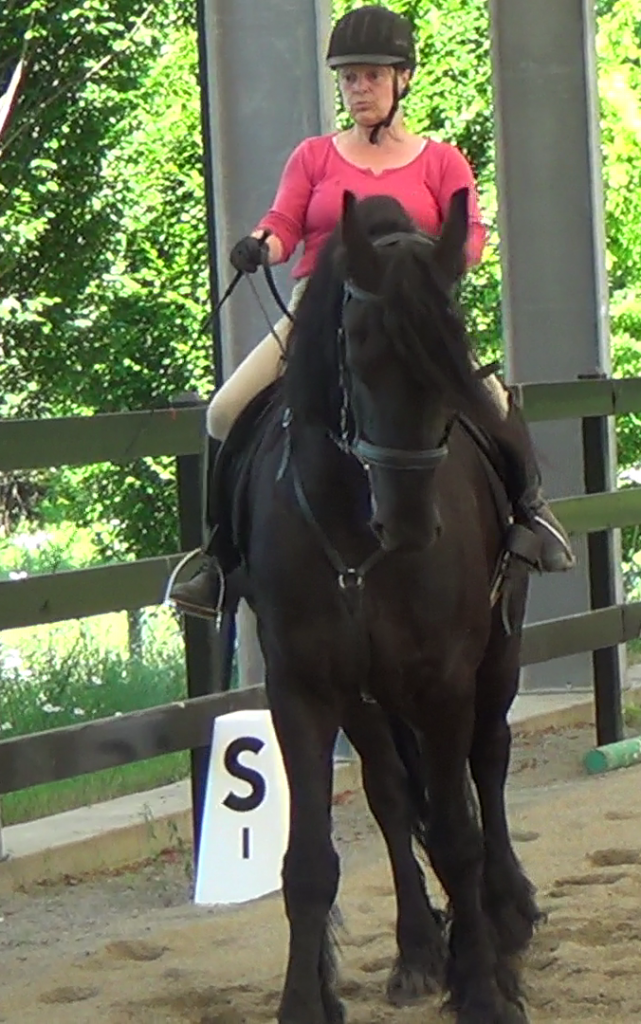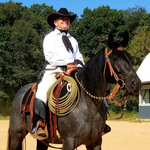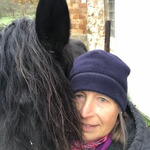Registration is full for March. Please signup for the waitlist for the next one.
Special Offer! Enroll now and get a 90% discount!
Lack of balance affects
circle shape and size
straight lines
speed consistency
Hi there, I'm Trish Hyatt and I love to help people learn from their horse.
I'm really glad that you're interested in how to improve your horse's balance.
Below are videos showing some of the things that can affect your horse's balance and examples of the feedback I will provide.
And I've include some tips you can apply to your horse.
If you'd like to learn more about your horses balance, how it's affecting performance and health, and what to do about it, I'd love you to join our upcoming clinic.
Problems that affect balance can cause the horse to either speed up (run-away),
or slow down (too lazy), to preserve their balance (not die!).
Falling onto the inside or outside shoulder
Causes the horse to get closer to or further away from objects.
- Puts undo strain on one front leg and hoof.
- Made worse by the horse's bend not matching the line of travel.
- Can indicate not carrying as much weight on the opposite hind leg.
We will correct shoulder issues by riding exercises that help us identify the best choices for our horse.
If it is a bend issue, we need to make sure we are also getting a true flexion. And that we don't bend the neck more than the spine.
Key takeaways: Falling onto or drifting through a shoulder, is usually not a shoulder issue. The solution depends on the cause.
Feedback to the Rider : Wrong bend on approach. Didn't get right flexion before turn and is falling on to right shoulder. Horse stayed on left flexion throughout. Focus on the Flexion/Bend lesson.
Losing the hindquarters
The hind feet do not always follow the tracks of the front feet.
We will identify the cause which could be
- inconsistent bend
- a weak hindleg that needs strengthening
- a change in the riders balance or aids
Feedback to the Rider :Notice how the horse steps to the right with the hind, on the left turns. This indicates a lack of bend in the ribs or not wanting or not able to carry as much weight on the right hind. This also causes the weight to fall to the left shoulder as you turn left, being pushed there from the right hind.

Try This:
The next time your horse is drifting sideways, try this on the side the horse is drifting to.
Imagine you are sitting (seatbone), and standing (stirrup), on a thumbtack.
To not get poked, you need to slightly lift your weight off the thumbtack. It is very subtle. No one should see you make a change. Just don't let that thumbtack poke you.
See if that helps your horse to not drift as much.
Bonus tip: If you want the horse to move sideways (leg-yield). Imagine the thumbtack is on the opposite side of where you want to go. The increase of weight in the direction of travel will help the horse move that way to get back underneath you.
In both cases, if you don't notice a difference don't make the movement bigger. It means there are other things we need to identify and correct. That is what we're going to work on in this clinic.
Being unbalanced is stressful.
Especially when you don't have control of your own feet.
Having the Wrong Flexion
Is your horse looking where he's going?
Try this now to see how it affects your own balance.
Walk a left circle looking left. Then continue left, but look right.
Most people will notice they start to land harder on the left foot and may even drift that way.
Imagine the result if you were going faster!
Looking where you are going helps you to stay in balance.
- Strain to the horses back is caused by a wrong flexion. The increased head elevation causes the back to lower and the hindlegs to not step under the body enough that they can support the weight.
- Any tension in this joint will cause tension elsewhere in the body. We need to learn to identify and correct the flexion, which we'll also start to do in this clinic.
This video clip shows a little bit of everything we've discussed. The tempo is rushing due to poor balance, and the balance is affected by the rushing. Her left hind tends to be carried to the left which means the right hind is the stronger one. Riding the horse in a left shoulder-in can help to strengthen this leg. It stepped out on the way back even though the horse was left bent at the time so it's not just slipping out because the horse is avoiding right bend.
Coming back the horse misses some flexion changes which contributes to her leaning towards the post with her shoulders. This is just part of the feedback this rider received on her ride to help her identify what to focus on in the exercises provided.
Try This Next time you're with your horse:
Hold your horses halter with a hand on each side of their cheeks. If safe to do so, stand in front and with gentle vibrations downward, or slightly side to side on the noseband, ask them to lower their head so you can see their mane.
It is a suggestion. You can not force is, or you will create tension.
Keep your hands in contact as they may lift their head or flick at a fly and bump you in the face.
Once you can see the top of the mane, suggest with little vibrations to one side, that they barely turn their nose that way. A flexion has less than 1" (2.5cm) of movement. If you don't see a change, you may already have it. Then try the other direction. Can you move your horse's nose either side of center, while the ears stay level?
If if doesn't move equally well both ways, they are bracing. If they seem to but the ears are not level, they are avoiding the flexion by ducking under it.
We will also work on this, in the online clinic.
It is a little thing, that you absolutely Must Have.
Grab your spot now.
This clinic is for the whole month of March!
- There is a new lesson online each week.
- You have all week to practice and submit Questions.
- Get a friend to shoot a quick video for discussion in the community and you may get bonus detailed feedback.
$
197
$27usd
Registration is full for March. Please signup for the waitlist for the next one.
Here’s what people are saying...

Kris Blacklock
Wisconsin, USA
Whether your new to Working Equitation or a seasoned competitor
The lessons heighten rider awareness, improve equine balance capabilities, coaches riders/horses within a shared supportive and friendly environment & provides tips to boost your confidence as you progress thru the levels.

Beth Rudy
USA
Everything to gain, Nothing to lose!
Gain small details/awareness that add up incrementally.
Great feedback, motivation to spend time in the saddle, build human-horse partnership, enjoy a supportive group, be Inspired by others working hard from other states/countries.

Allison Mazurkiewicz
Tall Grass Horsemanship
It works for all levels and all horses.
It addressed the main weaknesses in execution of an obstacle and gave me tools to help myself as well as my horse. I was able to improve my obstacle work by following the clear directions, that included some video analysis in the supportive online community.
Frequently Asked Questions
How much time will I need each week?
What if I miss a week?
What if I can't ride in March?
How do I access the clinic?
About Trish Hyatt
International Coach and Clinician
National and International Top 10 Competitor
Technical Delegate and Judge of Working Equitation
Trish Hyatt puts her many skills to use introducing the international discipline of Working Equitation to riders eager to improve their partnership with their horse, with a focus on fun, classical horsemanship and use of the horse for practical work or as cross-training for other disciplines.
Creating courses and teaching online for 5+ years.
Trish's superpower is the ability to give you and your horse what you need in a way that you understand so each horse and rider makes progress and knows what they need to work on.
$
197
$27usd
Registration is full for March. Please signup for the waitlist for the next one.